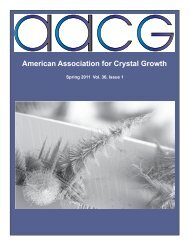President's Corner (cont.) - American Association for Crystal Growth
President's Corner (cont.) - American Association for Crystal Growth
President's Corner (cont.) - American Association for Crystal Growth
You also want an ePaper? Increase the reach of your titles
YUMPU automatically turns print PDFs into web optimized ePapers that Google loves.
nylon and Dacron factory in Germany. They requested<br />
the University to provide someone who could translate<br />
their drawings from English to German, and translate the<br />
regulations from German to English. Dutchmen know<br />
German pretty well, so I was delegated by the physics<br />
department to do this. Very interesting work, given my<br />
chemical engineering background, but it did slow down<br />
the work <strong>for</strong> the degree.<br />
DB: Did you consider going back to the Netherlands<br />
after university?<br />
LB: Well, I finally finished the PhD, and I met an <strong>American</strong><br />
girl. We soon got married, but she didn’t want to go<br />
to live in Europe. So I applied <strong>for</strong> citizenship and soon<br />
found a job at EG&G at their laboratory in Santa Barbara,<br />
where they needed a crystal grower to grow mercuric<br />
iodide crystals. At that time their main consultant<br />
was none other than Professor Michael Schieber from the<br />
Hebrew University in Jerusalem. When I showed him<br />
the crystals I had grown, he was excited and insisted that<br />
I come to EG&G. I would need to have citizenship, but<br />
with help from EG&G my papers came through in six<br />
months.<br />
DB: Did you develop a new crystal growth process at<br />
EG&G?<br />
LB: I found that the biggest problem was preparation of<br />
the materials <strong>for</strong> crystal growth. You have to start with<br />
highly pure materials. I think this is a common problem<br />
you see in the literature. It is clear that many times the<br />
starting material is not pure enough to get high quality<br />
crystals. So the group that I worked with designed new<br />
furnaces to purify and grow HgI 2 <strong>for</strong> nuclear radiation<br />
detectors.<br />
DB: Where were you when they approached you to become<br />
an astronaut <strong>for</strong> NASA?<br />
LB: That was when I worked at EG&G in Santa Barbara,<br />
in the early 1980’s. NASA had decided that with<br />
the new shuttle, they needed good crystal growth experiments<br />
<strong>for</strong> the SpaceLab. So we put in a proposal, not<br />
thinking we would be selected, and we were very surprised<br />
that NASA came back and accepted our proposal.<br />
Of course, NASA was very interested in studying fluid<br />
dynamics, inspired partly by Rosenberger, so we designed<br />
a crystal growth system that could be used in space under<br />
low-gravity conditions. But when the operations group<br />
in Houston looked at the design and procedures of the experiment,<br />
they decided they could not train in two years<br />
one of their astronauts to become a full-fledged crystal<br />
Moving around in the Spacelab.<br />
grower. Instead NASA requested a group of volunteers<br />
from the scientific community to be trained as astronauts.<br />
NASA established an investigators’ working group, with<br />
my boss Wayne Schnepple as the head.<br />
He received a letter requesting a list of 16 names of people<br />
who would like to do this job of growing crystals in<br />
space. He asked me “How do we find 16 guys who are<br />
willing to do this?” We sent letters to all members of the<br />
AACG asking <strong>for</strong> volunteers to be trained as an astronaut<br />
<strong>for</strong> Spacelab 3. Out of that we received only 15 credible<br />
answers, because not many people want to do this, as it<br />
turns out. You have to sacrifice about two years from<br />
your career, not to mention the strain on your family.<br />
So Wayne said to me “We have to make a good impression<br />
on NASA, so why not put your name on the list as<br />
the 16th volunteer?” Of course I had poor eyes, and a<br />
lot of other little problems, so I agreed, knowing that on<br />
the first round of selection, I would be ruled out. Then,<br />
based on educational backgrounds, NASA whittled the<br />
list down to eight acceptable individuals. After that, the<br />
science PI’s on the Spacelab 3 program were to select<br />
the four most qualified to do the experiments. I was still<br />
on the list, because I had quite a few years of experience<br />
growing crystals. At that point, it was too late <strong>for</strong> me to<br />
say “No, I don’t really want to do this.” Wayne said, “<br />
The next step will be the NASA physical, and there you<br />
definitely will wash out. So don’t worry.”<br />
So seven of us men and one woman went <strong>for</strong> a threeday<br />
intensive physical at NASA. From 7:30 am to 4:30<br />
pm you never stop, except <strong>for</strong> a half-hour lunch. At the<br />
clinic, a nurse takes many blood samples from you and<br />
escorts you from one test station to another. This is after<br />
fasting <strong>for</strong> 24 hours. If you can take that <strong>for</strong> three days,<br />
AACG Newsletter Winter 2013 9




